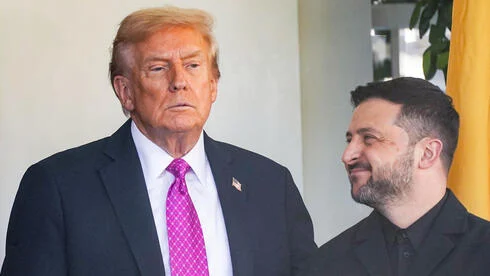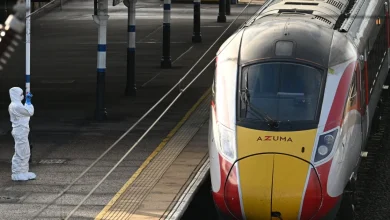Will Trump supply Ukraine with the missile that scares Putin?

The Pentagon has given the White House the green light to supply Ukraine with long-range Tomahawk missiles Kyiv has been eager to receive, after assessing that such a move would not deplete U.S. stockpiles, CNN reported Saturday, citing three American and European sources familiar with the matter.
However, the final decision remains in the hands of U.S. President Donald Trump. According to the report, Trump chose to halt the move following a phone call with Russian President Vladimir Putin, who warned that supplying the missiles would escalate the conflict and harm relations between Washington and Moscow.
Trump: ‘Sanctions on Russia’
(Video: Reuters)
About two weeks ago, in a conversation with reporters during his visit to Israel and Egypt to celebrate the end of the war in Gaza, Trump called the Tomahawk “an amazing weapon” and threatened that he might consider supplying it to Kyiv if Putin did not agree to a ceasefire. According to American sources, the Joint Chiefs of Staff submitted their recommendation to the White House just days before Trump’s meeting with Ukrainian President Volodymyr Zelensky – who requested the missiles to target oil and energy facilities deep inside Russia. Sources in Kyiv say the Tomahawk issue is part of a broader $90 billion security procurement deal that Zelensky is proposing to the U.S.
4 View gallery
Trump and Zelensky meeting
(Photo: AP Photo/Alex Brandon)
The Tomahawk missiles, with a range of about 1,000 miles (approximately 1,600 km), are considered among the most significant strategic American weapons. In Europe, it was assessed that the Pentagon’s approval removed the last “excuse” for Washington to supply the missiles. Kremlin spokesman Dmitry Peskov said this month that Moscow is “very concerned” about this possibility, describing it as “a dramatic moment due to the escalation of tensions among all parties.” Putin’s spokesman also emphasized that Tomahawk missiles are theoretically capable of carrying nuclear warheads: “Reminder – a long-range missile is launched and flies, and we know it can be nuclear. What will the Russian Federation think? How exactly will Russia respond? Military experts overseas need to understand this.”
However, in a heated White House meeting that week – reportedly rising to very high tensions and reminiscent of the “shouting summit” in February – Trump reversed course and told Zelensky that the U.S. “needs” the missiles for itself. Behind closed doors, he made clear that, for now, they will not be delivered. According to European sources, the U.S. president seemed to echo the narrative propagated by the Kremlin, warning Zelensky that if he does not accept Putin’s peace terms – which include a full withdrawal from Donbas – “he will face annihilation.” Reports indicate that the meeting escalated into sharp tones, with the American president reportedly cursing repeatedly during the discussion.
4 View gallery
Tomahawk missile launched by USS Cape St. George
(Photo: REUTERS/U.S. Navy/Intelligence Specialist 1st Class Kenneth Moll/File Photo/File Photo)
These sources said that Trump changed his position just one day after the phone call with Putin, in which the Russian president warned that Tomahawk missiles could strike cities like Moscow and Saint Petersburg without altering the balance of power on the battlefield. His decision comes after the failure of his summit with Putin in Alaska in August, which did not achieve a breakthrough to end the war.
The Pentagon, for its part, is not concerned about shortages in stockpiles – but acknowledges that significant operational challenges remain. Chief among them is how Ukraine would actually operate the system, train crews and launch Tomahawk missiles without a functioning naval fleet. One option being considered is supplying land-based launchers developed by the U.S. Army and Marines.
Sources in Europe noted that British Storm Shadow missiles were previously adapted by Ukrainian engineers for use on older Soviet aircraft – and they believe that in this case, Kyiv will also find a solution. “The Ukrainians have already proven that they can improvise engineering solutions,” one of them told CNN.
4 View gallery
improvising engineering solutions. The Ukranian army in action
(Photo: REUTERS/Sofiia Gatilova/File Photo)
Meanwhile, Trump – who had already expressed frustration over the stalemate in talks with Putin – imposed new sanctions on Russian oil companies and canceled the summit that had been planned between the two in Budapest. Nevertheless, after the meeting, Trump reiterated that “they should stop where they are, both declare victory, and let history decide.”
In the interim, the Ukrainian Navy announced that it struck energy facilities inside Russia last night – a thermal power plant in the Oryol region and an electricity distribution facility in the city of Novobriansk – using domestically produced Neptune cruise missiles. According to the statement posted on Telegram, both facilities supplied power to military factories in the area, and the hits constitute “a heavy blow to Russian logistics.” Ukraine usually uses drones for strikes deep inside Russia, but in recent weeks there has been an increase in the use of domestically produced precision missiles, indicating an improvement in Kyiv’s ability to hit targets deep inside Russian territory.
4 View gallery
Nothing came of the summit with Trump. Putin
(Photo: Alexander Kazakov, Sputnik, Kremlin Pool Photo via AP)
Zelensky published an official statement yesterday praising the forces: “There were many military reports today, detailed updates from the front. Of course, Pokrovsk is our priority. We continue to destroy the occupier, and that is the most important thing – to stop the Russian strikes everywhere and at all times,” he wrote, adding: “The Russians want to turn our entire country into what they are doing in Pokrovsk and Kupiansk; they must be stopped where they have arrived and destroyed there. Thanks to every unit, every soldier, sergeant and officer defending the positions and the country.”




